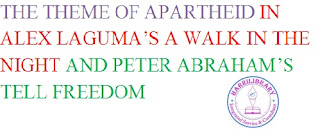The Theme of Apartheid in Alex Laguma’s A Walk in the Night and Peter Abraham’s Tell Freedom
CHAPTER
ONE: INTRODUCTION
1.1 Background of the Study
Apartheid, on Afrikaans word meaning “A state of being apart” was
a system of racial segregation in South Africa, enforced through legislation by
the national party (NP) Government, which was the ruling party in South Africa
from 1949-1990.
Apartheid had decimated effects not only on the blacks but anyone
classified as non-whites in South Africa. Racial segregation has been for centuries but the new
policy started in 1948 which was sticken and more systematic.
This policy did not leave any aspect of social life untouched.
During this time, existing pass laws were also strengthened. This law required
non-whites to carry document to authorize their presence in some areas that
were restricted. This experience was so formidable as blacks were to present “a pass” before
they could walk freely on the road. In fact, a black man with a pass reported
by Fuyard in Sigwe Bansi is Dead was better than to exist without a “pass” for a life without a
pass was worst than dead itself.
In 1953, the Education segregation law was passed stating that the
non-whites who were considered as the subordinate people shouldn’t have access
to quality education.
Blacks were corralled into township, if they could get jobs in the
city. If not, their urban shacks often were bulldozed and they were forcibly
moved to unproductive “homelands”. This was at the heart of the policy of
Apartheid or “separateness”.
Young men who, because of their situation in life, lack of
opportunity and colour have been prevented from achieving anything progressive
and from achieving any ambitions.
The purpose of the South African Apartheid laws was to force the black community
not to mingle with the white community. This ensured that they had to live in
separate neighbourhoods, use separate public transport, medical care, public
beaches. It also included the prohibition of marriage between whites and
non-whites. The Apartheid Experiences of Black African’s in Alex Laguma’s A
Walk in the Night And Peter Abraham’s Tell Freedom
It is on the above crises that this work aimed at examining the
Apartheid experiences of Black Africans in Alex Laguma’s A Walk in the Night and Peter Abraham’s Tell Freedom.
1.2 Statement of the Problem
Apartheid itself was a problem the blacks experienced during that
era. The majority of the native (non-whites) were treated differently from
whites (including blacks and other minorities and even poor whites) were forced
to live in different areas, go to separate stores, schools and hospitals,
treated differently at work and were not allowed to interact with the whites.
Michael suffers the same fate in A walk in the Night. He uses alcohol to hell quell his rage. At one
point, he is harassed by a police officer. He eventually heads home to face the
consequence of being unemployed and only to find himself in the gang just to
survive.
The Blacks worked tireless but were badly paid by the white
master. Nelson Mandela suffered suit even in his home town. This racial
discrimination and segregation become a thing of interest to the researchers as
the experienced are shared in the discourse. The Apartheid
Experiences of Black African’s in Alex Laguma’s A Walk in the Night And Peter
Abraham’s Tell Freedom.
1.3 Purpose of the Study
The purpose of the study is to examine the apartheid in South
Africa.
Specifically, the research work will consider the following South
African literature:
(i) Apartheid
experience as portrayed in Alex Laguma’s A walk in the Night.
(ii) Apartheid
experience as portrayed in Peter Abraham’s Tell Freedom.
(iii) Nelson Mandela’s A long walk to Freedom.
(iv) This study will exposed
the wickedness of the white against black and the racial segregation.
1.4 Significance of the
Study
The study will help the readers to understand the ills of the
Apartheid Government. The study will help in making the students and society to
appreciate literary works as a means of conveying and revealing societal crises
and how it would be corrected.
Also the knowledge acquired from this study will be very useful to
other researchers who may carry further studies in related or similar area.


No comments